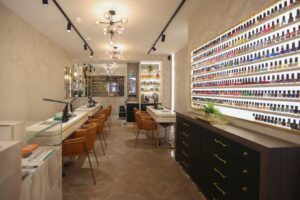How safe is your manicure? The hidden health risks of unsterilised salon tools
-
date of publication: 06/05/2025
Reading TIME: 3 MIN 10 sec
-
Author of the post: Oblique
When was the last time you questioned the hygiene practices at your favorite nail salon?
Many of us don’t think twice about the tools being used on our hands and feet, yet the consequences of poor sterilisation can range from minor infections to serious health complications.
The UK nail care market is projected to grow by 2.19% from 2024 to 2029, reaching an estimated market volume of 39 billion by 2029 according to Statista market research. With the average Brit spending £4.5k on self-care each year, nail salons have become an essential part of many people’s routines. But are the tools used in your salon hygienic, and is your safety being prioritised? Mariana Eidelkind, Founder of Oblique House of Nails, shares her expert advice on how to identify the signs of unclean practices and what you can do to protect yourself from hidden health risks.

About Oblique House of Nails
Interview with Mariana Eidelkind, Founder of Oblique
Why Are Unhygienic Mani-Pedi Tools a Concern?
Improper tool sterilisation is a serious concern because it increases the risk of transferring harmful bacteria, fungi, and viruses from one client to another. When tools like nail clippers, files, and cuticle pushers are not adequately cleaned, they can carry harmful pathogens that may lead to infections such as fungal infections, bacterial infections, and even bloodborne diseases like Hepatitis B, Hepatitis C, and HIV. These infections are not always visible immediately, making it especially dangerous as clients may unknowingly be exposed to health risks. Additionally, improperly sterilised tools can cause cuts or nicks in the skin, which can act as entry points for these harmful microorganisms. In the worst cases, untreated infections can lead to long-term health issues, so proper sterilisation is a key part of maintaining not only hygiene but also client safety.
How to Identify If Your Salon is Cutting Corners on Hygiene
It can sometimes be difficult to know if a salon is cutting corners on hygiene, especially when you’re new to the space. However, there are several red flags to watch out for. One of the most obvious is the use of visibly dirty or unclean tools. If your technician uses tools that are left out on the countertop, it’s likely that bacteria, dirt, and oils have accumulated on them. Clean, sterilised tools should be kept in sealed and sterile pouches until they are ready to be used. Also, check whether the salon uses single-use items, like nail files, buffers, or even towels. These items should never be reused across clients unless they are thoroughly sterilised in between.It’s also worth asking your nail technician directly about the salon’s cleaning and sterilisation processes. A reputable salon will explain their processes with confidence and transparency, as client health and safety should be a priority for them. If they struggle to answer your questions or avoid them, it’s a sign that their hygiene practices may not be up to standard.
Red Flags to Watch For
- Tools stored in liquid disinfectant only (not sufficient for complete sterilisation)
- Foot baths without disposable liners or visible cleaning between clients
- Technicians who don’t wash their hands between clients
- Reuse of emery boards and buffers between clients
- Lack of visible autoclave or sterilisation equipment
The Sterilisation Process Every Salon Should Follow
Industry standards according to the UK Beauty and Nails Association require proper sterilisation procedures that align with health and safety regulations. This includes:
- Disinfection (chemical cleaning)
- Cleaning (removing physical debris)
- Sterilisation (heat or pressure treatment)
- Proper storage in sterile conditions
How to Protect Yourself During a Nail Salon Visit
The first step to protect yourself during a nail salon visit is to have awareness and ask the right questions. A lot of people feel rude or uncomfortable to ask about the salon’s sterilisation process, but a reputable salon should have no problem explaining how they clean and sterilise their tools. Ask whether they use an autoclave or medical-grade sterilising equipment, as these are the most effective methods for ensuring proper hygiene.
As well as this, be aware of the general cleanliness of the salon. The station where your manicure is done should be clean and free of dust, debris, and leftover nail products. The technician should also wash their hands before starting your manicure and wear gloves to ensure hygiene. If something feels off, or if you notice the salon is not following proper hygiene protocols, don’t hesitate to leave and find a reputable salon that won’t compromise your safety.
Finally, if you have any cuts or broken skin on your nails or hands, it’s a good idea to let your technician know so they can take extra precautions to prevent any potential risk of infection.
Conclusion
Date of publication06/05/2025







